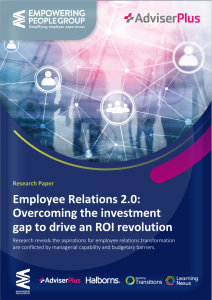From reactive to ready: Empowering HR through digital transformation
Many organisations, even some of the largest, struggle to identify the root causes of employee dissatisfaction, low productivity or high employee turnover. Research shows that more than 40% still rely on employee relations case management tools that are not fit for purpose, like ticketing systems, and even Excel. As a result, valuable HR insights are not visible.
In today’s rapidly changing business environment, these traditional approaches may not be scalable enough to keep up with the evolving needs of an organisation.
- Restricting and delaying access to real-time data about workplace conflicts can make it difficult to identify timely resolutions.
- Hidden achievements across departments can prevent the sharing of best practice and mentoring opportunities.
- Allowing unresolved workplace issues to escalate into formal disputes unnecessarily may lead to grievances or an increase in sickness absences, further disrupting operations.
Embracing digital transformation in organisations can have a powerful impact on reducing workplace disputes and effectively managing HR issues. By leveraging data-driven strategies and implementing fit for purpose HR technology, organisations can proactively address people matters and prevent conflicts from arising. This approach can create a positive work environment and enhance productivity.
Explore this blog and read this insightful research paper to delve further into the findings.
Less than 40% of companies have visibility of key HR metrics
 The reality is stark: Less than 40% of surveyed companies have full access to people metrics that can effectively inform decision-making. This data gap is particularly common in larger corporations, where outdated HR case management tools impede the visibility of extensive data sets. Understanding and addressing this issue is crucial for improving organisational effectiveness and strategic planning.
The reality is stark: Less than 40% of surveyed companies have full access to people metrics that can effectively inform decision-making. This data gap is particularly common in larger corporations, where outdated HR case management tools impede the visibility of extensive data sets. Understanding and addressing this issue is crucial for improving organisational effectiveness and strategic planning.
The cost of inaction: The consequences of not taking action in HR can be significant. Without access to important HR insights, it becomes challenging to stay informed and address issues that affect employee well-being and productivity. This can lead to problems like rising sick leave, high turnover, and grievances – all of which can significantly impact the bottom line.
Why digital transformation should be HR’s top priority
Organisations that invest in fit for purpose HR technology are better positioned to make data-driven decisions and proactively prevent the issues mentioned above, allowing them to enhance the employee experience and performance.
One of the most impactful HR digital transformation investments a business can make is in the management of employee relations processes. By capturing the right people data in an accurate, accessible, and secure way, organisations can prevent costly inefficiencies and inconsistencies in the long run.
To illustrate this, here is a typical scenario that many organisations face.
The situation today
Sarah is a team leader at a large retailer. Her team’s sickness absence rate is skyrocketing and grievances are at an all-time high. Sarah is escalating issues to HR regularly and the issues are impacting the morale of the team, which is also suffering its highest rate of employee churn.
Sarah’s team is facing significant challenges, leading to her feeling overwhelmed. While HR has been involved in managing employee relations issues through case management and backfilling vacancies, a more proactive approach is crucial. This reactive approach leaves Sarah struggling with a heavy workload and a burnt-out team.
Months have passed and nothing is improving. It feels like an endless cycle for Sarah and it is impacting the success of her area and taking its toll on her wellbeing too.
The critical role of data integration in employee relations
Outdated employee relations processes and fragmented HR data can make it difficult to identify valuable patterns or trends, leading to a lack of insight and actionable steps to take meaningful actions to prevent and address workplace issues. For example, if you can’t identify why employees are leaving, you can’t address the root cause and improve retention and overall performance within the organisation.
Breaking down data silos and integrating HR data can enable HR professionals to gain a comprehensive understanding of employee trends, empowering them to proactively address and resolve any issues that may arise.
The solution: Invest in fit for purpose HR technology
 The solution to effectively addressing employee concerns lies in investing in HR technology that is tailored to the specific needs of the organisation. Through digital transformation, managers can utilise self-service tools to address issues in real-time, minimising the need for heavy HR involvement. This proactive approach allows for the early identification of potential problems, leading to their resolution before they escalate into formal cases unnecessarily.
The solution to effectively addressing employee concerns lies in investing in HR technology that is tailored to the specific needs of the organisation. Through digital transformation, managers can utilise self-service tools to address issues in real-time, minimising the need for heavy HR involvement. This proactive approach allows for the early identification of potential problems, leading to their resolution before they escalate into formal cases unnecessarily.
By embracing this empowering approach, not only does the organisation save valuable time and reduce financial and legal risks, but it also drives a culture of proactive problem-solving within the workplace. In more complex situations, the use of self-service tools can significantly decrease the occurrence of employment tribunals, averting substantial financial liabilities.
The post-digital transformation scenario
Sarah is now using a self-service case management platform to manage employee relations issues, which means she doesn’t need to engage HR in every instance. She has access to information and guided journeys on how to have positive conversations about issues her team members are experiencing, like the burnout that is contributing to long-term sickness absence.
Alerts trigger tasks for her to proactively approach employees, such as when they hit sickness absence triggers, and she has all the template letters and email communications she needs at her fingertips to ensure she manages cases in a consistent and compliant manner. This enables her to focus on the employee experience in the moment, without having to escalate every employee relations matter to HR.
Sarah is now hearing firsthand from her team members the issues that are causing them to feel overwhelmed and disengaged. She knows what steps she needs to take in each instance, and this has given her the confidence to engage more proactively with her team members. The result is that team members facing performance challenges are now receiving better support, reducing the need for formal interventions.
Sarah’s consistent case management data helps identify recurring problems and allows for early intervention, improving overall team performance. The new case management tool ensures a smoother flow of information, notifying the HR team efficiently when their expertise is required in complex situations. This provides HR with all relevant details, enabling them to make well-informed decisions leading to better resolutions.
The benefits to HR
HR regularly review employee relations case data. They have seen that there was a spike in sickness absence and grievances in Sarah’s department in recent months because they now have benchmark data from across the business. Based on this insight, they reviewed the employee relations case history to identify any obvious issues that may be the root cause of these spikes. They found that there is a recurring issue of poor communication from leadership within the team.
HR reached out to Sarah and offered additional manager training. Sarah is given access to a mentor in a department which has below-average sickness absence and employee relations issues and Sarah learns some invaluable compassionate management techniques to help support her team members.
Within months, Sarah witnessed a transformative impact. Productivity soared, sick leave reduced, and team morale improved. As a manager, she felt a deeper sense of fulfilment and a stronger emotional connection with her team.
Strategic investment: Setting your organisation up for long-term success
 Investing in the right HR technology is not just a short-term solution, but a long-term investment that can significantly improve your organisation’s efficiency and productivity. By streamlining processes, reducing manual errors, and enhancing employee engagement, the benefits of investing in fit-for-purpose HR technology will continue to pay off over time. It’s a smart move that ultimately pays for itself and sets your company up for success in the long run.
Investing in the right HR technology is not just a short-term solution, but a long-term investment that can significantly improve your organisation’s efficiency and productivity. By streamlining processes, reducing manual errors, and enhancing employee engagement, the benefits of investing in fit-for-purpose HR technology will continue to pay off over time. It’s a smart move that ultimately pays for itself and sets your company up for success in the long run.
Is your organisation experiencing a similar scenario where your managers, similar to ‘Sarah’, could benefit from digital transformation?
It is essential to take a step back and assess the need for digital transformation in critical HR processes to ensure effective decision-making and overall organisational success. By evaluating the requirements for digital transformation, you can find the best innovative solutions that can empower your managers and improve their performance and growth.
Explore real examples of business transformation achieved in 2023 here.
Explore HR transformation case studies
Maximise returns: Employee relations transformation and data-driven HR
Creating a robust business case is crucial when it comes to transforming employee relations. While the benefits are substantial, they may not always be immediately apparent to business leaders. By seeking expert support in creating a business case for employee relations transformation, HR leaders can clearly illustrate the positive impact this can have on the bottom line. This includes not only reducing costs related to sickness absence and tribunal claims but also enhancing employee engagement, which in turn boosts productivity and retention rates.
Don’t wait to embrace digital transformation in HR. A data-driven approach to employee relations empowers HR leaders to make informed decisions that lead to a more agile and responsive workforce that is better equipped to handle change and drive sustained success.
Get in touch today and reap the benefits long-term: Our award-winning employee relations case management software, empower®, combined with decades of HR expertise, can help you drive positive change, empowering your managers to build a thriving culture. Contact us today to explore areas for improvement, including enhancing your workforce experience and maximising your ROI.
Try our ROI cost savings assessment
We encourage you to take our cost savings assessment. This tool will provide insights into how leveraging employee relations data can lead to significant cost savings and operational efficiencies.